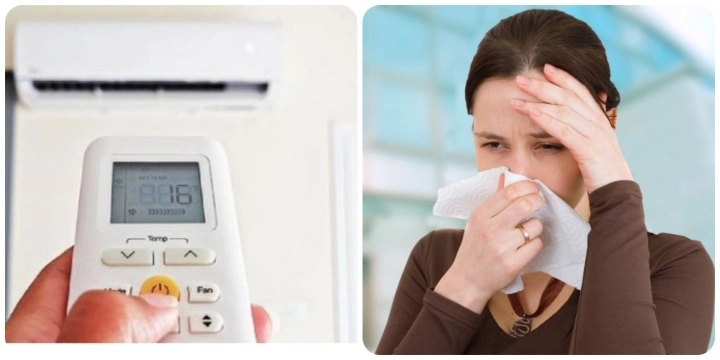On hot sunny days, everyone wants to stay indoors in the coolest possible room with the air conditioning turned on. Many people even set their air conditioning temperature to as low as 16 degrees. So, does turning on the air conditioning at 16 degrees consume a lot of electricity?
Does turning on the air conditioning at 16 degrees consume a lot of electricity?
Many people have the habit of using the air conditioning on extremely hot days by lowering the temperature on the remote to the lowest level, in the hope that the room temperature will reach the set temperature (16 degrees Celsius).
And at the end of the month, many people complain on Facebook that their electricity bill has increased three or four times and they don’t know why. According to experts, this is a wrong and extremely energy-consuming way of using air conditioning.
According to VnExpress, with regular air conditioners, the device will operate at full capacity to reach the temperature set by the user. The role of the air conditioning is to automatically shut down the operation of the outdoor unit when it reaches this temperature threshold. However, in hot and sunny conditions, the room temperature after the heat exchange with the surrounding environment will quickly rise, and the air conditioning will have to start again. This repetitive process will reduce the lifespan of the air conditioning as it has to constantly restart and consume a lot of energy.
With Inverter air conditioners, the machine’s capacity is gradually reduced when the room temperature reaches the appropriate level to compensate for the increased heat from the devices in the room or from the outside transmitted through the walls and doors. Thanks to this method, Inverter air conditioners can save more energy.
However, this is only true when the temperature is set to the optimal level. The ambient temperature that the human body adapts to is around 25 – 27 degrees Celsius. Therefore, setting the temperature to 26 degrees Celsius ensures comfort in daily activities.
If the temperature is set lower, the air conditioning will have to operate continuously until it reaches the newly set temperature. During this process, the device consumes more energy than a regular air conditioner, especially when used for a short period of time. Although very “smart”, Inverter air conditioners can only reduce operating capacity and cannot exceed the device’s limit capacity.

Tips for turning on and adjusting the air conditioner to save electricity
Do not turn the air conditioning on and off frequently
Some people often turn off the air conditioning when it is cool enough, turn on the fan to save energy, and only turn it on again when the room gets hot. But in reality, this method consumes more electricity as the air conditioning has to start and stop multiple times, causing the machine to break down faster.
According to appliance experts, turning the air conditioning on and off frequently will make the compressor and fan motor start and stop multiple times and cool down to the set temperature when the room temperature rises. This means consuming much more electricity, three times the energy needed to maintain the room’s coolness. The advice from experts is to turn on or off the air conditioning about 30 minutes before entering or leaving the room.
Choose the “dry” mode
Dry mode (water drop icon) consumes less electricity as the air conditioning removes moisture from the room, making the air dry and comfortable. However, users should use this mode when the environment has high humidity, over 60%.
Meanwhile, in hot and dry conditions, with humidity below 50%, choosing the Cool mode is recommended. Experts confirm that air conditioning set to Cool mode will make the room cooler than when set to Dry mode. Especially on hot days when the temperature rises above 40 degrees Celsius, the Dry mode has little effect, it only makes the room hotter and uncomfortable.
Schedule the air conditioning to turn off
Most air conditioners have a timer function, and newer models also have a Sleep function. The timer button on the remote control is very useful and that is one of the simple ways to use the air conditioning to save electricity that we often forget.
Use the air conditioning’s timer function to set the desired turn-off time. Especially at night, when the temperature drops, to avoid feeling cold and having difficulty sleeping, you can use the turn-off or sleep feature to set it according to your preferences.
Timers not only ensure a good night’s sleep without feeling cold, but also help save electricity effectively. On average, the air conditioning consumes 1 kWh of electricity every hour. The more time you can reduce the air conditioning’s operation, the more the electricity bill will decrease.
Choose the appropriate air conditioning capacity for the room size
If the air conditioning runs at high capacity, it will consume a lot of electricity, or if it runs at low capacity, it will not operate efficiently, and will not guarantee the cooling effect for the room. Therefore, before installing an air conditioner for a room, you need to calculate the size or volume of the room to be able to choose the right air conditioning capacity.
If the room area is less than 15m2, a 9000 BTU air conditioner is sufficient. For rooms ranging from 15 to 20m2, a 12000 BTU air conditioner is recommended. For areas under 30m2, a 18000 BTU air conditioner is suitable, while from 30 to 40m2, a 24000 BTU air conditioner should be chosen. If you are planning to buy an air conditioner for a baby, you need to calculate and choose carefully to avoid affecting the baby’s health while still helping the baby sleep well on hot summer days.
Turn off the air conditioning about 30 minutes before going out
According to the recommendations of experts, it is best to turn off the air conditioning about 30 minutes before going out. During this time, the room temperature is still cool enough for you to feel comfortable, and turning it off in advance will save electricity. Moreover, at this time, the temperature slowly drops to allow the body to adapt, avoiding thermal shock when going outside.
Add a small capacity fan
If the room has air conditioning, adding a small capacity fan will help distribute the cool air more evenly and make us feel cooler.
Thanks to this, instead of setting the room temperature to 25 degrees Celsius, we can set it to 28 degrees Celsius with a small fan. This helps save a relatively large amount of electricity.
With the above information, you must have found the answer to the question “Does turning on the air conditioning at 16 degrees consume a lot of electricity?”
Source: vtc.vn
Important Guidelines to Follow When Utilizing a Washing Machine’s Dryer Function
If you’re looking for ways to maximize the efficiency of your washing machine and dryer, we’ve got just the advice for you! Follow a few simple guidelines and you can increase the performance of your machines, save time and energy, and reduce noise levels. To get started, here’s a look at the best practices for using the dryer function of your washing machine!
Increases in Energy Efficiency Achieved with Slow Cookers
As the demand for convenient cooking continues to rise, more and more families, especially those with young children, are turning to slow cookers as a way to create healthy and tasty meals with minimal effort. With so many settings and benefits, slow cookers offer a great solution for busy households.






































